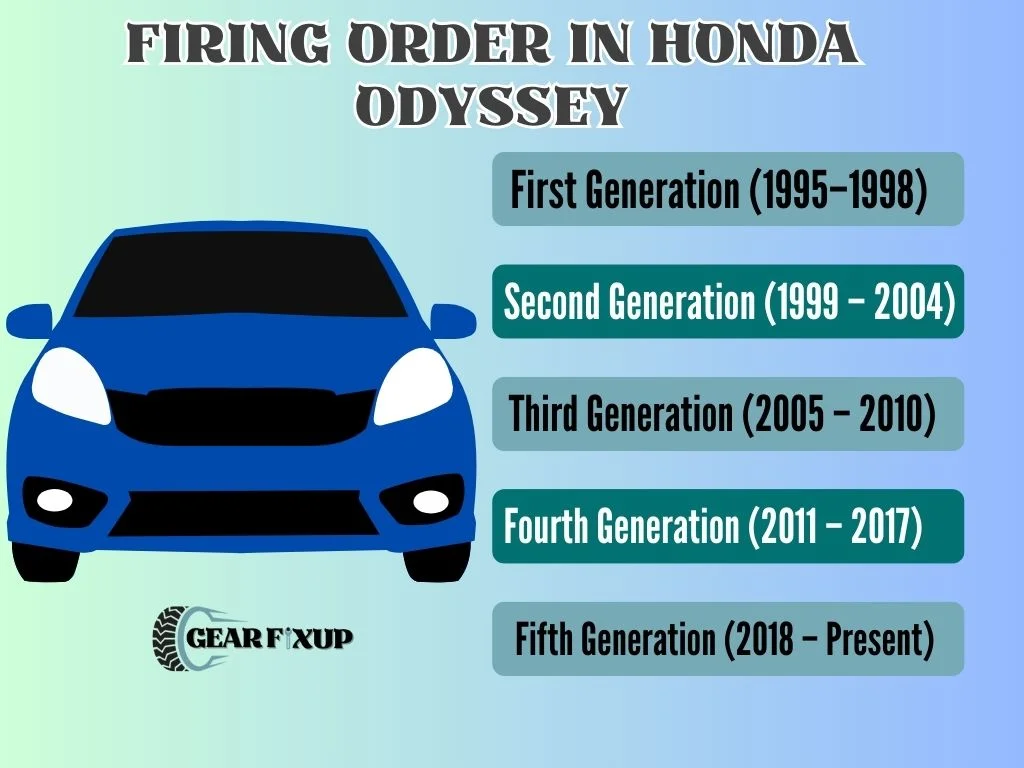Engine blocks are equipped with cylinders that are arranged in a particular firing order.
During combustion, one cylinder is in the intake stroke and the other cylinder is in the exhaust stroke.
Having all cylinders fire at the same time would result in uneven power output and crankshaft failure. Additionally, the engine misfires if a cylinder does not ignite.
![Honda Odyssey Firing Order [1995-Current]](https://gearfixup.com/wp-content/uploads/2024/01/Honda-Odyssey-Firing-Order-1995-Current.webp)
A lack of combustion or incomplete combustion usually causes it. When the car runs, the engine feels like it’s shaking.
Vibration and sound produced by the engine are also affected by the firing order.
Why Firing Orders Are Important & What They Mean
Each cylinder is ignited in a precise sequence for optimal performance that is referred to as the firing order. A Honda Odyssey equipped with a 2.2L or 2.3L 4-cylinder engine runs on 1-3-4-2 timing, with the distributor rotating clockwise.
Inline 4-cylinder engines have cylinder ignition sequences of 1, 3, 4, 2. A balanced combustion force and smooth operation can be achieved by following this exact order.

From 1995 to present, Odysseys with 3.5L V6 engines have a firing order of 1-4-2-5-3-6. Distributorless ignition is available. V6 engines benefit from this sequence, which minimizes vibration through evenly spaced power strokes.
While servicing Odyssey ignition components, it is crucial to follow the manufacturer’s recommended firing order. If ordered incorrectly, engines can run rough, vibrate, perform poorly, and wear prematurely.
Depending on the size and configuration of each engine, Honda engineers optimize the sequence. Odyssey’s smooth power delivery and longevity are a direct result of adhering to their specifications.
Honda Odyssey Engine Overview
As Honda Odyssey generations evolved, engineers optimized the engine’s responsiveness, efficiency, and reliability by using a range of four-cylinder and V6 engines.
A 2.2L inline 4-cylinder engine produced 140 horsepower for the first generation models from 1995-1998, which were later upgraded to a 2.3L engine for the second generation models.
In addition to the 4-cylinder engine, the Odysseys of the second generation offered a 3.5L V6 engine that generated 210 horsepower.
You may read Honda Odyssey VSA Light: Causes & Solutions
It was the third generation Odyssey that introduced Honda’s technologically advanced variable cam timing, now putting out 255 horsepower and offering the only engine option.

This high-performance V6 was retained in later fourth and fifth generations, but Variable Cylinder Management was introduced to maximize efficiency in real-world conditions by deactivating cylinders when not needed.
Technicians should have a thorough understanding of the Odyssey engine’s engine history and configurations from 1995 forward to be able to properly maintain the powerplant. This is accomplished by knowing the engine’s generation-specific technical evolution.
How Are Engine Cylinders Numbered
An engine’s cylinders are usually numbered from front to rear by most manufacturers.

However, this may also be determined by the engine type. A straight engine, for instance, has a different numbering system than a V engine and a radial engine.
Straight Engines
Straight engines have one row of cylinders. There are four-cylinder, six-cylinder, and eight-cylinder models.
To number the cylinders in the rear of the engine, we start at the front of the engine.
Radial Engines
Unlike conventional engines, the cylinders in this type are arranged in a wheel-like structure. The crankcase is centrally located and the cylinders are arranged around it.
Circular numbers are assigned to the cylinders, as the name suggests. It is usually the top cylinder that is the first. The firing order is maintained by having an odd number of cylinders in each bank.
Engines with this configuration can be found in aircraft.
Read more about Honda Odyssey’s 3.5 Firing Order – The Engine’s Rhythmic Heart
V Engines
There are two banks of cylinders in these engines. Linked to a crankshaft, each bank has the same number of cylinders. Due to the angle between the two banks, the engine has the shape of a V.
There are two ways in which a V engine is numbered. The engine numbering on a V engine, for example, looks like this;
The Honda Odyssey is powered by this kind of engine. The engine firing order of the vehicle is discussed below.
Firing Order in Honda Odyssey
It depends on the engine’s design and how many cylinders it has. Understanding the Honda Odyssey firing order requires knowledge of its engine type.

As the Odyssey engine has evolved since 1995, the Japanese automaker Honda has made several improvements. Due to this, Honda Odysseys have also been offered with different cylinder configurations over the years.
Here’s how the Honda Odyssey’s firing order has changed over time.
First Generation (1995–1998)
Four-cylinder engines were available in either 2.2L or 2.3L configurations for the first generation.
In the 2.2L, 140 horsepower was produced, while in the 2.3L, 150 horsepower was produced. Both engines were mated to four-speed transmissions.
Both the 2.2 and 2.3L engines had 90 degree crankpins since they were four-cylinder engines.
There are three cylinders firing in this engine, four in the next, and two in the next, and the distributor rotates clockwise.
Second Generation (1999 – 2004)
This generation features Honda’s 3.5L V6 engine, which is more powerful. The transmission also had four speeds.
210 horsepower was the result, which was very impressive for a minivan. In 2002, however, a 5-speed transmission with 240 horsepower debuted.
There is no distribution rotation system on this 3.5L V6 engine, so the firing order is 1-4-2-5-3-6.
Third Generation (2005 – 2010)
A 5-speed automatic transmission mated to the same 3.5L V6 engine as in the previous generation was retained in this generation. With 244 horsepower, it was slightly more powerful.
The Honda i-VTEC Variable Cylinder Management System was introduced in this generation to increase fuel efficiency. LX, EX, EX_L, and Touring were the trim levels of this generation (VCM).
VCM is available only on Honda’s EX and Touring trims. Accordingly, the vehicle could be driven with three, four, or all six cylinders.
This generation’s firing order is determined by Honda’s VCM. Because it is a V6, all cylinders are fired sequentially, 1 to 4, 2 to 5, 3 to 6.
Fourth Generation (2011 – 2017)
With a five-speed automatic transmission, the 3.5L V6 engine was still used in this generation.
However, some trim levels came with automatic transmissions with six speeds. 248 horsepower were produced by this generation.
The firing order of this generation of Honda Odysseys was also dependent on the cylinder deactivation system.
There are six cylinders in the engine, and they are fired in the order 1-4-2-5-3-6.
Fifth Generation (2018 – Present)
The Honda Odyssey is currently in its third generation. As with the previous model, it has a 3.5L V6 engine that can deliver 280 horsepower. Transmissions with either 9 or 10 speeds are paired with this engine.
Honda’s VCM dictates the same firing order as the previous generation. A six-cylinder engine, however, fires in the following order : 1 – 4 -2 -5 -6.
Read: Honda B13 service
Read: Honda B17 Service
Read: Honda Check Charge System
Read: Honda A13 Service [What It Included & Cost]
Read: Honda Maintenance Code A127 Explained
Read: Honda B14 Service
Read: Honda A17 service
Frequently Asked Questions
What is the firing order on a 99 Odyssey?
The following are the firing order details for Honda Odyssey models equipped with the 3.5L V6 engine: 1-4-2-5-3-6 Distributorless ignition system (one coil per cylinder).
Where is the cylinder 3 on a 2011 Honda Odyssey?
Located closest to the driver’s side of the engine on the 2011 Honda Odyssey is cylinder #3, which is situated on the side nearest the windshield.
What causes misfire Honda Odyssey?
Over the past seven years, the Odyssey’s third cylinder has been leaking oil around the spark plug and causing the engine to misfire. It’s not noticeable at high speeds due to the engine shutting down two cylinders.
What is the correct firing order?
There are a few British engines that use the firing order 1-2-4-3, but many straight-four engines follow a firing order of 1-3-4-2. The firing order for flat-four engines is R1-R2-L1-L2. A straight-five engine has a firing order of 1-2-4-5-3 to minimize primary vibrations.
Conclusion
Knowing when there are problems with the cylinders in the Honda Odyssey requires understanding the firing order.
Due to its ability to reduce vibrations caused by irregular power output, a correct firing order gives you a smooth ride.
Driving a Honda minivan with this technology ensures the maximum level of comfort for the driver and passengers.
The engine bay and cabin area will also be quiet when the cylinders are firing correctly. As a result, the Honda Odyssey’s ride experience will also be improved.
Furthermore, a correctly arranged firing order can save gas. Honda’s VCM system demonstrates this by deactivating some cylinders based on driving conditions.
It does this while still providing decent power so that the driver experience is not compromised.



![Honda A15 Service [What Is Included & Checklist, Cost]](https://gearfixup.com/wp-content/uploads/2024/02/Honda-A15-Service-What-Is-Included-Checklist-Cost-150x150.webp)
